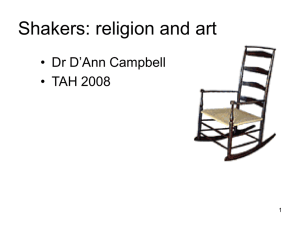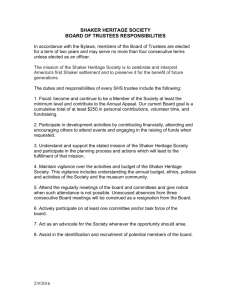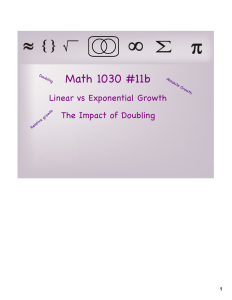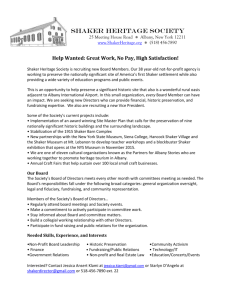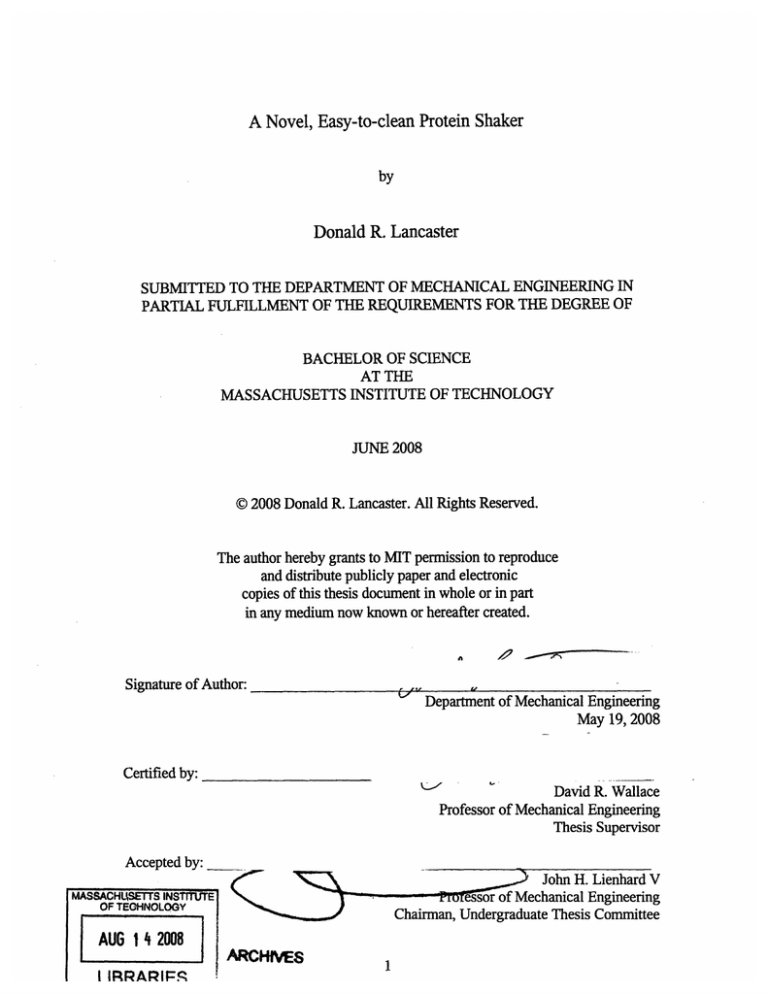
A Novel, Easy-to-clean Protein Shaker
by
Donald R. Lancaster
SUBMITTED TO THE DEPARTMENT OF MECHANICAL ENGINEERING IN
PARTIAL FULFILLMENT OF THE REQUIREMENTS FOR THE DEGREE OF
BACHELOR OF SCIENCE
AT THE
MASSACHUSETTS INSTITUTE OF TECHNOLOGY
JUNE 2008
© 2008 Donald R. Lancaster. All Rights Reserved.
The author hereby grants to MIT permission to reproduce
and distribute publicly paper and electronic
copies of this thesis document in whole or in part
in any medium now known or hereafter created.
9
Signature of Author:
. --
.
.
.
,,
__
Department of Mechanical Engineering
May 19, 2008
Certified by:
David R. Wallace
Professor of Mechanical Engineering
Thesis Supervisor
Accepted by:
•
MASSACHLk.SETTS INSTiTUTE
OF TECHNOLOGY
AUG 14 2008
BIL RARIES
-
,
John H. Lienhard V
rressor of Mechanical Engineering
Chairman, Undergraduate Thesis Committee
ARCHIVES
1
A Novel, Easy-to-clean Protein Shaker
by
Donald R. Lancaster
Submitted to the Department of Mechanical Engineering
On May 19, 2008 in partial fulfillment of the
requirements for the Degree of Bachelor of Science in
Mechanical Engineering
Abstract
The goal on this thesis project was to develop a novel, easy-clean protein shaker.
Protein shakers are used to contain and mix protein supplementation powder and water or
liquid of the user's choice. Due to the nature of products within the fitness theme, shakers
should be easy to use and low maintenance. Significant problems with current protein
shakers are bacteria build-up in hard-to-reach places, low quality seals, mouthpiece caps
separating from the shaker, and unsatisfactory mixing. Therefore, the goal of this project
was to design and prototype a protein shaker that would be easy to clean, preventing
unnecessary bacteria build-up in hard-to-reach locations in the shaker.
In order to identify the needs of shaker users, an investigation into what current shaker
users believed important in a product was conducted. A new design that eliminated all
corners and crevasses was proposed and a prototype was constructed using rapid
prototyping technology. The prototype provided further insight to additional improvements
that could be made to the design. The goal of being easy to clean was successfully
achieved.
Thesis Supervisor: David R. Wallace
Title: Professor of Mechanical Engineering
Table of Contents
Title..................................................
Abstract............................
..............................
............................................
1
2......
Table of Contents ................................................................... 3
1 Introduction .......................
............................................... 5
1.1 Background..............................
................... 7-11
2 Considerations of Current Shaker Users........
........................13-14
3 Design of Easy-Clean Protein Shaker .................................... 14-18
4 The Prototype.............................
..................................20-22
5 Conclusions and Future Work......................................... 22-23
6 References..............................
......................................... 24
(page intentionally left blank)
1 Introduction
In the world of fitness, the protein shake is used for nutritional supplementation not
just after workouts, but at any time, in any place. In this fast-paced world, it is a functional
requirement for shakers to need less effort to maintain and to keep bacteria-free. Though it
is best for protein shakers to be cleaned immediately after the drink is finished, it's not
always possible since they are sometimes taken on-the-go. With this in mind, when a shake
is finished, there is usually a little bit of protein left over that will sit at the bottom of the
shaker or in/on any groove in the bottle. If this sits for more than a couple hours, bacteria
will begin to grow, the shaker will smell, and the container will be even harder to clean. If
the shaker has grooves that are thin, such as threads, or areas where normal water flow (i.e.
from a faucet) is disrupted, as provided by corners or irregular shapes in the bottle, the
build-up can be even tougher to clean.
This thesis project aims to design a protein shaker that is easy to clean. The final
image of the shaker can be seen in Figure 1.
Fig. 1: 3-D Print of Easy-Clean Shaker. Shown is the assembled prototype.
The structure of this document follows a similar sequence as that of the design process that
went into the shown prototype. Beginning with benchmarking present-day protein shakers
and understanding the needs of the users, the design is finalized and finally, a prototype is
made. Once the prototype is tangible, additional improvements to the design can be noted
and made.
(page intentionally left blank)
1.1 Background
In order to understand shakers in the current market, an investigation was
conducted to benchmark existing shakers and search for any ensuing trends. The shakers
chosen for the benchmarking came from a random sample of Zesiger Center patrons. That
being said, not all patrons used containers that were designed to be protein shakers. This
fact, however, allowed for more design flaws to be highlighted.
Some shakers
exhibited a focus on the mixing and blending of the drinks. The shaker shown in Fig. 2
even featured a compressible, wire-frame agitator to improve mixing capabilities.
Figure 2: Blender Bottle@. This is a protein shaker with an emphasis on mixing the drink.
(The agitator can be seen in bottle on right.)'
Although this is a high-quality protein shaker with respect to mixing performance, it was
not designed with clean-ability as a top priority. It has sharp corners in the bottom, grooves
on the sides of the bottle to give the inside an irregular shape, and the inside of the cap has
detailed indentions (shown in Fig. 3, page 9) that provide a "high-traffic" location of the
bottle a means of protein and bacteria build-up.
(page intentionally left blank)
Fig. 3: Blender Bottle@ cap. A cap with protein build-up in the indentions of the cap.'
Other shakers in the sample appear to have been designed with little focus other
than aesthetics. The shaker shown in Fig. 4 has circumferential indentations for style as
well as a detailed cap design for a rugged look.
Fig. 4: BSN brand shaker. Shaker pictured above has circumferential indentations and an
intricate cap for aesthetics. 2
(page intentionally left blank)
This shaker accomplishes its goal of being aesthetically pleasing; however, it is
exceptionally hard to clean, leaving it with build-up in the cap and grooves in the bottle.
As seen in Fig. 5, in the shaker cap, nearly everywhere there is detail, there is build-up.
Fig. 5: Inside view of BSN brand cap. As can be seen in the picture, the cap has many
details inside. It has corners and grooves that fingers cannot even fit into. To give a sense
of scale, the mouthpiece (located at the top of the picture) is approximately the size of a
quarter.2
Bottles used by patrons that were not designed to be protein shakers gave additional
insight to features that are difficult to clean. Some bottle openings were too small to fit a
hand in, so the bottom of the bottle could only be cleaned by shaking soapy water in the
bottle. This method is not very effective if any amount of protein has been sitting in the
container for several hours. In order for the user to clean the bottle properly, he/she must
have some cleaning utensil that can fit through the opening and scrub the bottom. As
described above, current protein shakers have many focuses; clean-ability is not a strong
one.
(page intentionally left blank)
2 Considerations of Current Shaker Users
For a product with the end user in mind, an investigation must be conducted to
understand the needs of the user. The investigation that was undergone took many
suggestions from another group of Zesiger Center patrons that could be broken down to the
following categories: shape, dimensions, aesthetics, functionality, and material selection.
These suggestions were "what they found important in a protein shaker."
An overwhelming amount of surveyed patrons mentioned the same things. Most
suggestions could be categorized as a shape or dimensional attribute. Patrons found it
important that the mouth of the bottle portion of the shaker be wide enough to fit any size
scoop. It was also found important that the bottle portion of the shaker was short enough to
fit under most sinks and to be able to fill up to over 80% capacity with the average water
fountain. Some patrons also wanted the shaker to be easy to hold and clean/dry, implying
that a hand should be able to fit in it most of the way. One suggestion for the shape of the
cap was for it to resemble a funnel so that the shake would be easy to drink fast. A
breakdown of the percentage of patrons favoring certain design suggestions is shown in
Table 1.The suggestions within the survey came under the premise that easy-clean design
parameters would be determined by the author.
Table 1: Support of design suggestions by sampled patrons (based on sample size of 10)
that were strongly considered in actual design of prototype.
Suggestion of Patron
Wide top to bottle
Height limit
Transparent bottle
Quality seal
Measurement lines
Funnel-shaped cap
Percent of patrons with this suggestion
80%
40%
60%
40%
60%
10%
Though no patrons mentioned exactly what the shaker should look, they mentioned
that it should be transparent so that the liquid level can be observed easily. A few also
mentioned that a dark-colored cap would be appealing. One specified attribute that can be
considered both aesthetic and functional is a set of measurement lines on the outside of the
bottle. Patrons also mentioned some attributes and features of importance to them that were
purely functional. Many wanted a cap that didn't leak or detach while in the shaking
process. One patron mentioned the possibility of a handle on the side of the bottle to aid the
user in shaking because mixing well is a definite requirement.
Transparency of the bottle deals not only with aesthetics, but material selection as
well. Along those lines, some patrons thought it would be enticing for the inside of the
bottle to have non-stick sides and to be smell resistant. Moreover, with the non-stick
feature still in mind, it was important to be able to write one's name on the outside with a
permanent marker.
3 Design of Easy-Clean Protein Shaker
Fig. 6: Prototype Cross-section. A cross-section of assembled prototype's solid model.
Respecting the suggestions of the surveyed patrons, the design of the prototype, shown in
Figure 6, began. To design the bottle portion of the shaker, the dimensional constraints
should be considered. It was suggested that it should be short enough to both fit under most
sinks and be able to fill up with an average water fountain. It was found that most kitchen
sinks have very high clearances, so they would not be the limiting factor here; it would be
bathroom sinks. An average clearance height in bathroom sinks, by measuring both MIT
residences and MIT public bathroom sinks, was found to be approximately 8-9". The next
check would be the average height of water fountain streams. Measuring fountain streams
from around the Zesiger Center and MIT's Infinite Corridor, the peak heights varied from
6-8". When filling up a bottle of any sort, the bottle doesn't need to be stood up, but rather
held at an angle. This means that the bottle being filled can be taller than the stream height
and still be filled most of the way. Another factor affecting how much the fountain can fill
the bottle is where the stream lands with respect to the edge of the fountain basin. Most
streams landed within 3-4" from the side of the basin, allowing the bottom of the bottle to
be held off the edge when being filled. It also needed to be easy to reach the bottom of the
inside portion of the bottle with one's hand, so it needed to be wide at the top. These were
the factors that determined the width of the mouth as well as the height of the bottle portion
of the shaker. To determine how the profile of the bottle would look, more specifically the
width of the base of the bottle, a bottle of similar size was considered. As a base for how
big a bottle could be before being too hard to hold, a 32 oz. Gatorade TM bottle3 was
benchmarked. The final width of the shaker bottle's base was held to 3 ¼",about a 3/8"
smaller diameter than the Gatorade TM bottle for safe measure. Finally, in order for the
bottle portion of the shaker to be easy to clean, it must have no corners, meaning that the
bottom must be somewhat hemispherical. However, the shaker must also be able to stand,
so to have the round bottom it must also have a skirt around it to be the standing base. To
provide additional clearance from the round bottom to the ground, the skirt was extended
about ¼"past the plane of the round bottom for stability purposes.
To begin the design of the cap, some sort of base for the layout needed to be
chosen. Since it too should have no concave corners, the cap was to be hemispherical in
nature as well. Thinking back to the suggestions of the surveyed patrons, it is necessary to
have a seal that will not leak. Due to the small radius of the threading grooves in most caps,
other sealing methods were investigated and a snap fit with an o-ring was chosen for its
clean-ability. The type of snap that worked best with the design of the shaker was a
cantilever snap.4 In this type of scheme, the outside of the bottle deflects the cantilevered
snap until it reaches the ledge on the bottle where it snaps back to zero deflection and is
secure to up and down motion (the removal of the cap). The amount of allowable
deflection, y, was determined using Equation 1.
2AL2
3h
[5]
(Eq. 1)
The model used for determining the dimensions of the snap can be seen in Figure 7.
Fig. 7: Cantilever beam model. The model shown was used for the calculations that
determined the size of the snap feature.
For sealing purposes, the o-ring is located between the outside of the cap and the inside of
the bottle.
(page intentionally left blank)
Determining the size of the mouthpiece for the cap required the making of a mock-up, as
shown in Figure 8.
Fig. 8: Shaker Mock-up. The mock-up shown above was made of paper, tape, half of a
tennis ball, and the mouthpiece of a Vitamin WaterTM bottle. The mock-up helped
determine if the dimensions of the bottle were plausible and how high the mouthpiece
should come out of the cap to avoid collisions with the user's nose while drinking. 6
Although the majority of protein shakers have the mouthpiece positioned off to one side of
the cap, the one for this shaker is placed in the center. Taking into account on patron's
desire for a funnel shape top for speed drinking, there are additional advantages with this
particular shape. The centered mouthpiece also gives it a symmetrical, streamline look. The
symmetry isn't purely aesthetic, however; it adds ease of use because the shaker can be
drunk from any orientation. A functional advantage is that it takes advantage of the
hemispherical shape of the cap. The mouthpiece utilizes the shape since the flow of liquid
is naturally directed to the center, when in a drinking position, extracting more protein from
the container than usual.
(page intentionally left blank)
4 The Prototype
From a solid-model of the design described in the previous section, a rapidprototype was 3-D printed, as seen in Figure 9.
Fig. 9: Components of Easy-Clean Shaker. From left to right is the fully assembled
shaker, bottle, and cap. Seen on the cap is the o-ring.
Since the round bottom of the bottle portion of the shaker cannot be seen from the
prototype, a cross-section of the solid model can be seen in Figure 10.
Fig. 10: Cross-section of Bottle. The picture shows a cross-section
taken from solid model
of prototype.
(page intentionally left blank)
As can be seen from Fig. 8, the bottle portion contains no comers to allow the build-up of
protein and bacteria, accomplishing the goal of being easy to clean. Although it appears
that there is a lip near the top of the bottle, it is merely a line that the solid modeling
software includes to indicate the interface of two walls of two different slopes. It is
extremely difficult to remove this line due to the vertical plane constraint of the bottle-cap
interface. Though the cap interface and the sloping wall of the bottle are of differing slopes,
the actual change is so minute that the slope-change line is undetectable to the eye. Also
shown in the picture is a wavy, radial cut around the skirt for aesthetics and stability
purposes.
5 Conclusions and Future Work
Details for aesthetics that affected the functionality or goals of this shaker were
avoided during the design process. The prototype produced is a protein shaker that has no
comers, ledges, indentations, or crevasses that cannot be reached by a hand or finger for
cleaning purposes where protein would be stored. Therefore, the prototype has proven that
the design would be easy to clean.
The final form of the prototype came with many suggestions as well as questions
for the future of this project. Currently, with the o-ring that is on the cap, the top and
bottom of the shaker cannot be fully attached. The main cause for this is a
clearance/spacing issue between the outside of the cap and the inside of the bottle. This
issue can be resolved by both decreasing the outer diameter of the cap wall facing the bottle
and making sure the o-ring is perfectly fit for the groove in the cap. Furthermore, with the
new clearance, it will become obvious that the tabs that open the snaps need to be wider
and more comfortable to engage. The current prototype has some sharp edges and corners
that were overlooked, including the current tabs and the bottom circular edge of the cap. In
the future, a stopper for the mouthpiece would be used to start testing its seal strength.
Then to fully test the prototype, it would either need to be made out of clear plastic, or if it
were 3-D printed again, it could be sprayed with a clear lacquer, for water-proofing.
Hopefully, it would be made out of clear plastic so that it can have measurement lines on
the outside to monitor the containing liquid's volume. Optimization of parameters
governed by the easy-clean form factors were a goal clearly met in this project, and making
the aforementioned minor changes will launch this prototype to market.
6 References
1. http://www.blenderbottle.com
2. http://www.bsnonline.net
3. http://www.gatorade.com
4. "Snap Fit Design". December, 2003.
http://engr.bd.psu.edu/pkoch/plasticdesign/snap design.htm.
5. Hibbeler, R.C. Mechanics of Materials, 6' Edition. Upper Saddle River: Prentice Hall.
2005.
6. http://www.vitaminwater.com

